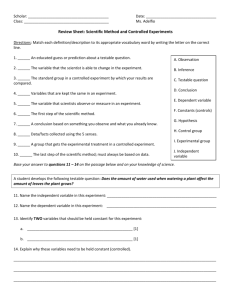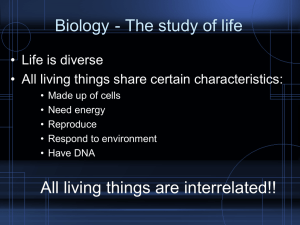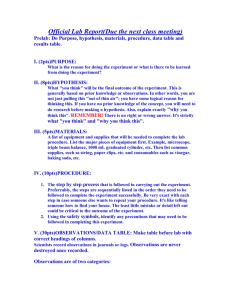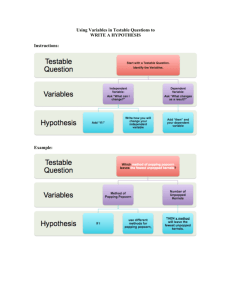Scientific Process PPT
advertisement
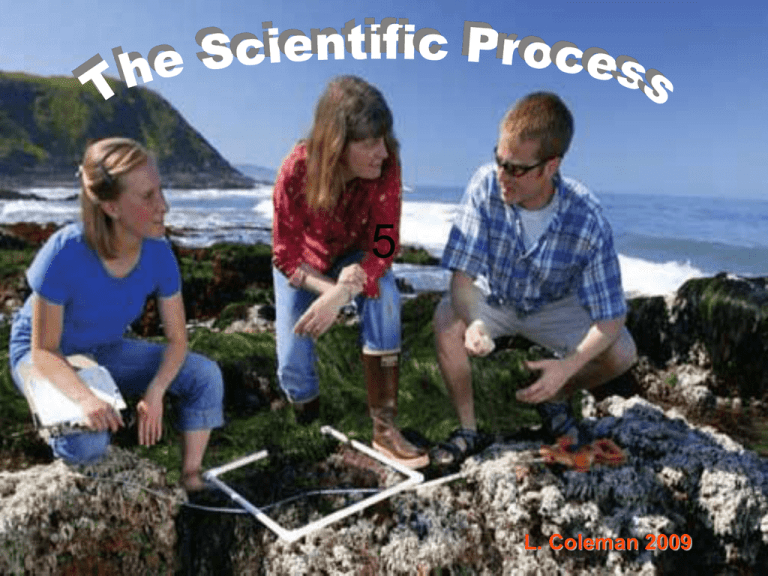
5 L. Coleman 2009 The scientific process: an organized way to solve problems and find answers to questions about the natural world. PURPOSE: Benefit society. 5. Share what you learned - PUBLISH Practical problem, curiosity, new technology or observation leads someone to… 1. Ask a QUESTION “YES”? 2. Form a HYPOTHESIS: 4. Form a CONCLUSION: Is hypoth. supported yes, no, partially? “NO” or “partially”? Revise one or both: predict the answer to the question ( must be testable) 3. Do the test (EXPERIMENT or make observations In the field) a. Use a control b. Make careful record of data KNOWLEDGE of the natural world. The Scientific Process starts with developing a… 1. Problem/Question: … that can be solved through experimentation or observation. [How, What, When, Who, Which, Why, or Where?] Example: Why, after rebounding for a few years, is the population of California sea otters declining again? Before proceeding to the next step, make observations and research your topic of interest. Do you remember the next step? 2. Formulate a Hypothesis: Predict a possible answer to the problem or question. Must be testable by experiment or observation. Example: Sea otters are dying from a cat parasite accumulating in the ocean as a result of runoff polluted by cat feces. 3. Do an experiment or make observations in nature to test your hypothesis. • Carefully record your observations (data). • If testing with an experiment, be sure you use a control*. Testing with an experiment. Testing by observation. * A control is the group (or item) that serves as the standard of comparison. A control is the same as the experimental group(s) in every way except that the control receives “no treatment”. Before going to the next step, organize and analyze results: (Often includes graphing and/or mathematical analysis of data) TITLE graphs Pressure change with temperature increase in a gas a. Is there a pattern (or patterns) in the data? If yes, what does it tell you about the purpose? b. Is there evidence that you may have made errors? Label axes include units! If so, study procedure to see where errors might have occurred. 4. Form a Conclusion: a. b. “By golly, I was right!” Summarize results. Describe patterns you identified. Hypothesize possible explanation(s) of patterns. Can you answer purpose based on your results? If so, do it! If not, say so and tell why. Support your statement with evidence from data. Do results support your hypothesis? If not, identify possible reason: c. d. e. – – Hypothesis wrong? Error(s)? f. Discuss any new questions that your work raises about the topic. 5. PUBLISH! • Share what you’ve learned so others can: - study your experiment - repeat it - pursue questions you raised. - and society can benefit from your work. • In this class, you share by writing a lab report! The body of knowledge of science comes from many sources: • Experimental and observational EVIDENCE. (obtained through the scientific process). • FACTS: directly observable phenomena agreed upon by all. (Example: “ people come in different heights”). • LAWS: Statements of fundamental relationships that always hold true under specific conditions. (Example: the Law of Gravity). THEORY LAW FACT LAW LAW Experimental evidence LAW Observational evidence 1. Evidence about a topic from all sources accumulates. 2. Scientists propose and test HYPOTHESES (possible explanations) to make sense of parts of it. 3. Rarely, someone develops a THEORY: something that explains and is consistent with every fact, law and bit of evidence on the topic. In everyday usage a“theory” is a guess. In science it means just the opposite.THEORIES ARE WHAT SCIENTISTS ARE MOST SURE ABOUT! 1. 2. Supported by HUGE bodies of evidence. If contradictory evidence arises, theory must be changed to include it. 3. Accurately predict future findings and results. Three theories organize our understanding of living things: 1. CELL THEORY 2. The “CENTRAL DOGMA” (How DNA Controls an Organism.) 3. THEORY OF EVOLUTION by NATURAL SELECTION.







